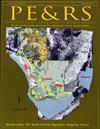使用真实数据评估表面网格重建
IF 2
4区 地球科学
Q4 GEOGRAPHY, PHYSICAL
引用次数: 0
摘要
表面重建的研究已经深入,但很少做的工作,以解决其评估。在这篇文章中,我们提出了新的基于可见性的度量来评估三维网格的完整性和准确性,基于一个比重建计算精度更高的点云。我们使用获得的每个高质量点的位置来计算相应的自由空间射线。基于每条射线与重建表面之间的交点,我们的度量允许评估重建的全局相干性和近距离精度。我们通过调查几个开源算法以及三个数据集上的一个许可软件来验证这个评估协议。结果证实了单独评估局部和全局精度的相关性,因为算法有时无法同时保证两者。此外,利用传感器位置的算法比只依赖点和法线的算法表现得更好,这表明这条信息具有潜在的重要附加价值。我们的实现可以在https://github.com/umrlastig/SurfaceReconEval上获得。本文章由计算机程序翻译,如有差异,请以英文原文为准。
Evaluating Surface Mesh Reconstruction Using Real Data
Surface reconstruction has been studied thoroughly, but very little work has been done to address its evaluation. In this article, we propose new visibility-based metrics to assess the completeness and accuracy of three-dimensional meshes based on a point cloud of higher accuracy than the one from which the reconstruction has been computed. We use the position from which each high-quality point has been acquired to compute the corresponding ray of free space. Based on the intersections between each ray and the reconstructed surface, our metrics allow evaluating both the global coherency of the reconstruction and the accuracy at close range. We validate this evaluation protocol by surveying several open-source algorithms as well as a piece of licensed software on three data sets. The results confirm the relevance of assessi ng local and global accuracy separately since algorithms sometimes fail at guaranteeing both simultaneously. In addition, algorithms making use of sensor positions perform better than the ones relying only on points and normals, indicating a potentially significant added value of this piece of information. Our implementation is available at https://github.com/umrlastig/SurfaceReconEval.
求助全文
通过发布文献求助,成功后即可免费获取论文全文。
去求助
来源期刊

Photogrammetric Engineering and Remote Sensing
地学-成像科学与照相技术
CiteScore
1.70
自引率
15.40%
发文量
89
审稿时长
9 months
期刊介绍:
Photogrammetric Engineering & Remote Sensing commonly referred to as PE&RS, is the official journal of imaging and geospatial information science and technology. Included in the journal on a regular basis are highlight articles such as the popular columns “Grids & Datums” and “Mapping Matters” and peer reviewed technical papers.
We publish thousands of documents, reports, codes, and informational articles in and about the industries relating to Geospatial Sciences, Remote Sensing, Photogrammetry and other imaging sciences.
 求助内容:
求助内容: 应助结果提醒方式:
应助结果提醒方式:


